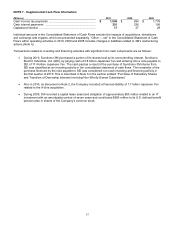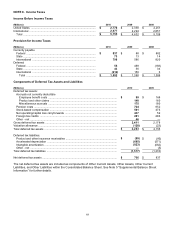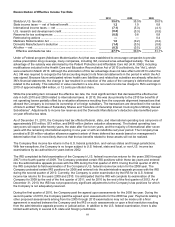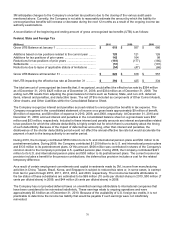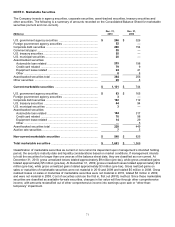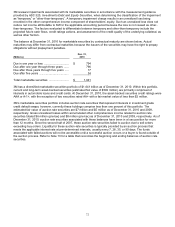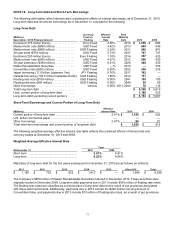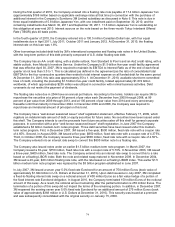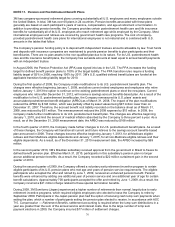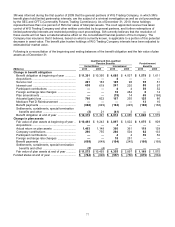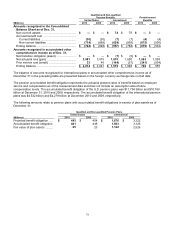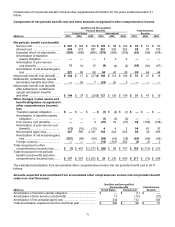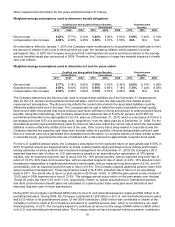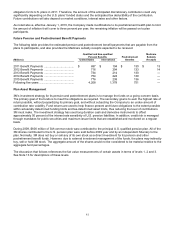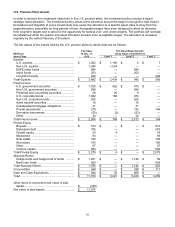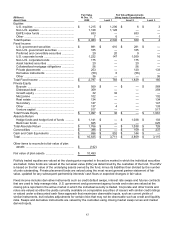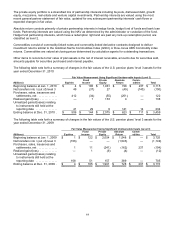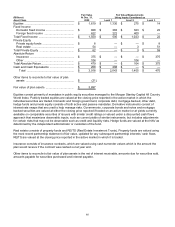3M 2010 Annual Report Download - page 82
Download and view the complete annual report
Please find page 82 of the 2010 3M annual report below. You can navigate through the pages in the report by either clicking on the pages listed below, or by using the keyword search tool below to find specific information within the annual report.76
NOTE 11. Pension and Postretirement Benefit Plans
3M has company-sponsored retirement plans covering substantially all U.S. employees and many employees outside
the United States. In total, 3M has over 60 plans in 24 countries. Pension benefits associated with these plans
generally are based on each participant’s years of service, compensation, and age at retirement or termination. In
addition to providing pension benefits, the Company provides certain postretirement health care and life insurance
benefits for substantially all of its U.S. employees who reach retirement age while employed by the Company. Most
international employees and retirees are covered by government health care programs. The cost of company-
provided postretirement health care plans for international employees is not material and is combined with U.S.
amounts in the tables that follow.
The Company’s pension funding policy is to deposit with independent trustees amounts allowable by law. Trust funds
and deposits with insurance companies are maintained to provide pension benefits to plan participants and their
beneficiaries. There are no plan assets in the non-qualified plan due to its nature. For its U.S. postretirement health
care and life insurance benefit plans, the Company has set aside amounts at least equal to annual benefit payments
with an independent trustee.
In August 2006, the Pension Protection Act (PPA) was signed into law in the U.S. The PPA increases the funding
target for defined benefit pension plans to 100% of the target liability. The PPA transition rules require a funding
liability target of 92% in 2008, reaching 100% by 2011. 3M’s U.S. qualified defined benefit plans are funded at the
applicable transition funding liability target for 2010.
During the first quarter of 2008, the Company made modifications to its U.S. postretirement benefits plan. The
changes were effective beginning January 1, 2009, and allow current retired employees and employees who retire
before January 1, 2013 the option to continue on the existing postretirement plans or elect the new plans. Current
employees who retire after December 31, 2012, will receive a savings account benefits-based plan. As a result of the
modification to the U.S. postretirement benefits plan, the Company remeasured its U.S. plans’ assets and
accumulated postretirement benefit obligation (APBO) as of March 31, 2008. The impact of the plan modifications
reduced the APBO by $148 million, which was partially offset by asset values being $97 million lower than on
December 31, 2007. Therefore, the accrued benefit cost liability recorded on the balance sheet as of March 31,
2008, was reduced by $51 million. The remeasurement reduced the 2008 expense by $15 million. In 2009, the
Company made further modifications to its U.S. postretirement benefit plan. The changes are effective beginning
January 1, 2010, and limit the amount of medical inflation absorbed by the Company to three percent a year. As a
result, as of the December 31, 2009 measurement date, the APBO was reduced by $168 million.
In the fourth quarter of 2010, the Company made further changes to its U.S. postretirement benefit plans. As a result
of these changes, the Company will transition all current and future retirees to the savings account benefits-based
plan announced in 2008. These changes become effective beginning January 1, 2013, for all Medicare eligible
retirees and their Medicare eligible dependents and January 1, 2015, for all non-Medicare eligible retirees and their
eligible dependents. As a result, as of the December 31, 2010 measurement date, the APBO increased by $69
million.
In the second quarter 2010, 3M’s Brazilian subsidiary received approval from the government in Brazil to freeze its
defined benefit pension plan. Effective March 31, 2010, participants in this subsidiary’s pension plan no longer
accrue additional pension benefits. As a result, the Company recorded a $22 million curtailment gain in the second
quarter of 2010.
During the second quarter of 2009, the Company offered a voluntary early retirement incentive program to certain
eligible participants of its U.S. pension plans who met age and years of pension service requirements. The eligible
participants who accepted the offer and retired by June 1, 2009, received an enhanced pension benefit. Pension
benefits were enhanced by adding one additional year of pension service and one additional year of age for certain
benefit calculations. Approximately 700 participants accepted the offer and retired by June 1, 2009. As a result, the
Company incurred a $21 million charge related to these special termination benefits.
During 2009, 3M Sumitomo (Japan) experienced a higher number of retirements than normal, largely due to early
retirement incentive programs, which required eligible employees who elected to leave the Company to retire by
September 2009. Participants in the Japan pension plan had the option of receiving cash lump sum payments when
exiting the plan, which a number of participants exiting the pension plan elected to receive. In accordance with ASC
715, Compensation — Retirement Benefits, settlement accounting is required when the lump sum distributions in a
year are greater than the sum of the annual service and interest costs. Due to the large number of lump sum
payment elections in 2009, the Company incurred $17 million of settlement charges.



